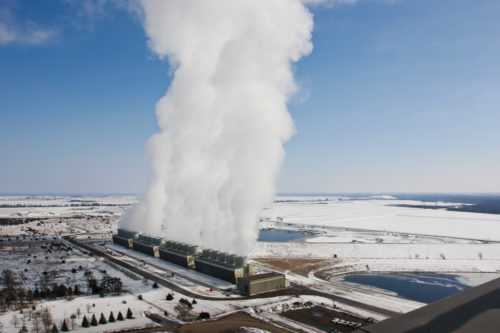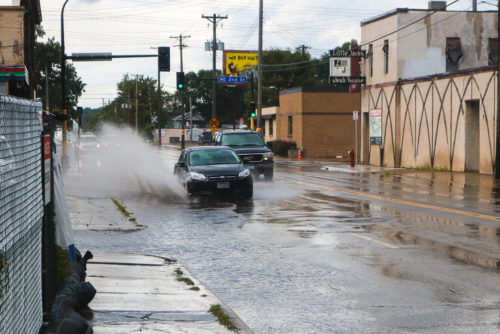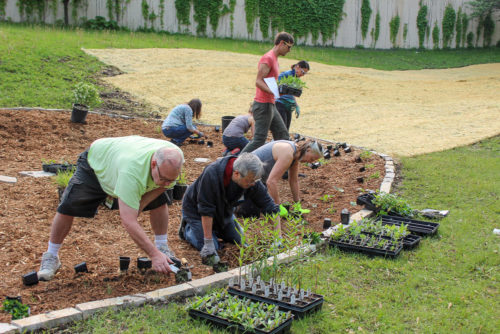It’s hard not to notice that storm events are more frequent and intense than they used to be, causing problems like street flooding and wet basements. Or, that lake and river levels are unusually high throughout the summer, forcing events to be canceled and damaging infrastructure. Or, that winters just aren’t as cold as they were when many of us were growing up.
These are just some of the most noticeable local impacts of climate change. According to the National Climatic Data Center, the average annual temperature in the Twin Cities increased 3.2 degrees Farenheit between 1951 and 2012, while the average annual rainfall increased more than 20 percent (5.5 inches) during that same time period. The impacts of this changing climate are real for Minnesotans, and it is imperative that we work together toward solutions and to build resilience in our watersheds to protect water quality and habitat in the face of these unprecedented changes.
Climate Change Basics

Climate change is caused primarily by the burning of fossil fuels for things like energy production and transportation. This process releases greenhouse gases like carbon dioxide (CO2) into the atmosphere. The accumulating greenhouse gases act like a blanket, trapping heat and altering the climate system.
Increased heat in the atmosphere causes increasing global temperatures, shifting weather patterns, and a more energy-charged atmosphere. This creates more extreme conditions, both in the form of increased powerful storm events and devastating droughts.
Without significant efforts to reduce greenhouse gas emissions, temperatures will continue to climb and the impacts of climate change will continue to become more extreme. Climate models project that average temperatures in the Twin Cities metropolitan area will rise an additional 3-5 degrees Fahrenheit by mid-century, and that heavy precipitation events will continue to become more intense and more frequent.
Local Impacts on Water, Habitat and Urban Infrastructure

Increased precipitation and warmer winters cause problems for water quality and habitat in our watershed. Increased runoff from more intense storms carries higher volumes of water and, in turn, higher pollutant loads into our stormsewer system and ultimately into rivers and lakes. Larger loads of sediment and nutrients in our local waterways mean bigger algae blooms and decreased oxygen levels. This, in addition to warmer water temperatures, threatens to make our rivers and lakes uninhabitable by many fish species and other aquatic life.
Increased stormwater runoff also poses challenges to our urban stormwater infrastructure. Our stormwater pipes were designed to manage average conditions in the past, but in many cases those pipes are not large enough to handle the volumes that come with large precipitation events. When the amount of rainfall in a particular period of time is more than the infrastructure can handle, the system backs up and we get flooding. While occasional minor flooding is to be expected, we know that with the forecasted increase in intense storms, these conditions will likely get worse.
What Can We Do?

In order to protect water quality, ecological health, and our social and economic systems, we need to work together to slow climate change and to adapt to new realities. Ultimately, significant reductions to greenhouse gas emissions will be critical to slowing down the warming of the atmosphere. In the meantime, we can take steps to help our communities adapt to the changing climate.
Green infrastructure plays an important role in managing large storm events and increasing precipitation. Rain gardens, for example, can manage large amounts of runoff, providing temporary storage and promoting infiltration through the soil and uptake into vegetation. Not only does this relieve some of the strain on the stormwater infrastructure, but by slowing the flow of water and encouraging it to percolate through soil, pollutants are trapped and removed.
Small-scale green infrastructure — like residential rain gardens, rainbarrels, or permeable pavers — manages relatively small amounts of stormwater compared with larger stormwater management projects like the Towerside District Stormwater System or our SART facility. However, a recent University of Maryland study demonstrated that small, distributed green infrastructure makes a big cumulative difference to the resilience of the watershed.
At the MWMO, we partner with neighborhoods and community groups to install some of these smaller-scale practices, with the intention that they become distributed and normalized in our watershed. These are in addition to the large green infrastructure projects that we do in partnership with our member cities and partner organizations. All of this together makes a significant impact on the quantity and quality of water flowing to the Mississippi River.
It’s important not to get discouraged when considering the magnitude of the impacts of climate change. Fortunately, there is hope. By working together to develop community level solutions to curb greenhouse gas emissions, green our neighborhoods and build stronger communities, it is possible to change the current trajectory. To learn more about climate change and find out how you can get involved, check out a few of the resources below.
Resources
- Climate Change and Minnesota — Minnesota Department of Natural Resources
- Climate Change in Minnesota — Minnesota Pollution Control Agency
- Climate Generation
- Environment Minnesota
- MN 350